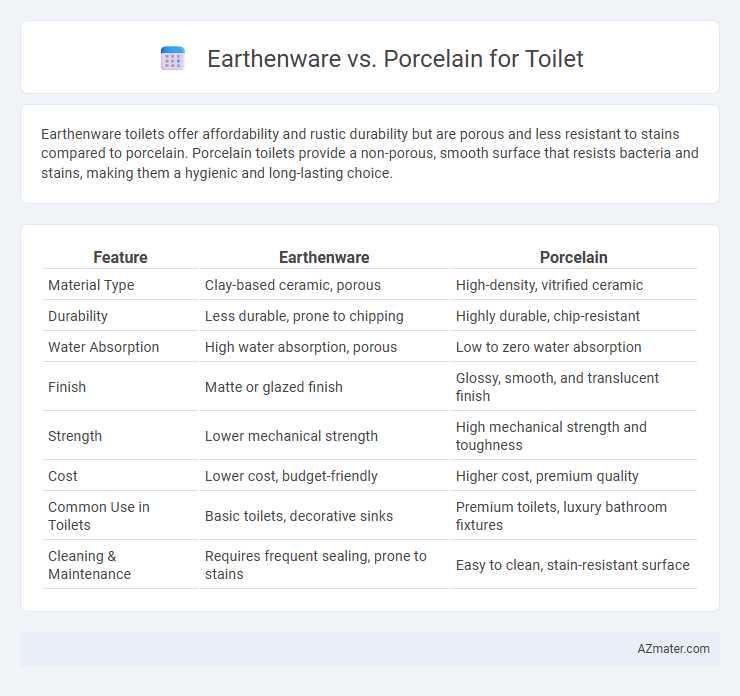Earthenware toilets offer affordability and rustic durability but are porous and less resistant to stains compared to porcelain. Porcelain toilets provide a non-porous, smooth surface that resists bacteria and stains, making them a hygienic and long-lasting choice.
Table of Comparison
| Feature | Earthenware | Porcelain |
|---|---|---|
| Material Type | Clay-based ceramic, porous | High-density, vitrified ceramic |
| Durability | Less durable, prone to chipping | Highly durable, chip-resistant |
| Water Absorption | High water absorption, porous | Low to zero water absorption |
| Finish | Matte or glazed finish | Glossy, smooth, and translucent finish |
| Strength | Lower mechanical strength | High mechanical strength and toughness |
| Cost | Lower cost, budget-friendly | Higher cost, premium quality |
| Common Use in Toilets | Basic toilets, decorative sinks | Premium toilets, luxury bathroom fixtures |
| Cleaning & Maintenance | Requires frequent sealing, prone to stains | Easy to clean, stain-resistant surface |
Understanding Earthenware and Porcelain Toilets
Earthenware toilets are made from clay fired at a lower temperature, resulting in a porous structure that requires a glaze for water resistance, making them more affordable but less durable compared to porcelain. Porcelain toilets are crafted from kaolin clay fired at higher temperatures, producing a dense, non-porous surface that offers superior durability, stain resistance, and a sleek finish. The key distinctions between earthenware and porcelain toilets affect longevity, maintenance, and aesthetic appeal, with porcelain being the preferred material for modern bathroom fixtures.
Material Composition: Earthenware vs Porcelain
Earthenware toilets are made from clay fired at lower temperatures, resulting in a porous and less dense material often coated with a glaze to prevent water absorption. Porcelain toilets, crafted from fine kaolin clay and fired at higher temperatures, create a vitrified, non-porous surface that offers superior durability and resistance to stains. The difference in material composition directly impacts the toilet's longevity, maintenance, and overall performance in residential and commercial settings.
Durability: Which Toilet Lasts Longer?
Earthenware toilets offer moderate durability with porous surfaces prone to chipping and staining over time, whereas porcelain toilets provide superior longevity due to their dense, vitrified composition that resists cracks and discoloration. Porcelain's non-porous glaze ensures enhanced resistance to everyday wear, chemical cleaners, and water exposure, making it less susceptible to damage. The lifespan of porcelain toilets typically exceeds that of earthenware, making porcelain the preferred choice for long-lasting bathroom fixtures.
Water Absorption and Stain Resistance
Earthenware toilets exhibit higher water absorption rates, typically around 10-15%, making them more prone to moisture retention and potential staining over time. Porcelain toilets contain a dense, vitrified surface with water absorption below 0.5%, offering superior stain resistance and easier maintenance. The low porosity of porcelain ensures enhanced durability and hygiene compared to the more porous earthenware options.
Aesthetic Differences in Finish and Color
Earthenware toilets showcase a rustic, matte finish with natural, earthy tones that bring warmth and traditional charm to bathroom designs. Porcelain toilets feature a smooth, glossy surface with a bright white or translucent appearance, offering a sleek and modern aesthetic. The color consistency in porcelain enhances a clean and polished look, while earthenware's subtle variations emphasize handcrafted uniqueness.
Weight and Installation Considerations
Earthenware toilets are generally heavier than porcelain ones, impacting ease of transport and installation due to their denser clay composition and thicker walls. Porcelain toilets offer a lighter alternative, often making them easier to handle and quicker to install, especially in residential settings. Weight differences also affect the choice of mounting hardware and may require additional support structures for heavier earthenware models.
Cost Comparison: Earthenware vs Porcelain Toilets
Earthenware toilets typically cost less, with prices ranging from $100 to $300, making them a budget-friendly option for basic bathroom installations. Porcelain toilets, known for their durability and glossy finish, generally range from $200 to over $1,000, reflecting higher manufacturing and material costs. Choosing between earthenware and porcelain toilets depends on balancing initial investment against long-term durability and aesthetic preferences.
Maintenance and Cleaning Requirements
Earthenware toilets require frequent sealing to prevent water absorption and staining due to their porous nature, making maintenance more intensive compared to porcelain. Porcelain toilets offer a smooth, non-porous surface that resists stains and is easier to clean with standard bathroom cleaners, reducing upkeep time and effort. Choosing porcelain ensures durability and hygienic advantages, especially in high-use environments where low maintenance is critical.
Environmental Impact of Each Material
Earthenware toilets generally have a lower environmental impact due to their simpler manufacturing process and use of natural clay, which requires less energy and fewer chemicals compared to porcelain. Porcelain production involves higher energy consumption and the firing of kaolin clay at extremely high temperatures, contributing to greater carbon emissions. Recycling and biodegradability are limited for both materials, but earthenware's lower production footprint makes it a more eco-friendly choice for sustainable bathroom fixtures.
Choosing the Right Material for Your Bathroom
Choosing the right material for your bathroom toilet involves considering durability and aesthetic appeal; earthenware offers a rustic, porous finish ideal for traditional designs but requires more maintenance due to its susceptibility to stains and cracks. Porcelain, with its non-porous surface and high density, provides superior resistance to scratches, stains, and bacteria, making it a hygienic and long-lasting choice for modern bathrooms. Evaluating factors such as budget, style preference, and maintenance needs will guide you in selecting between earthenware's charm and porcelain's sleek, durable performance.

Infographic: Earthenware vs Porcelain for Toilet
 azmater.com
azmater.com